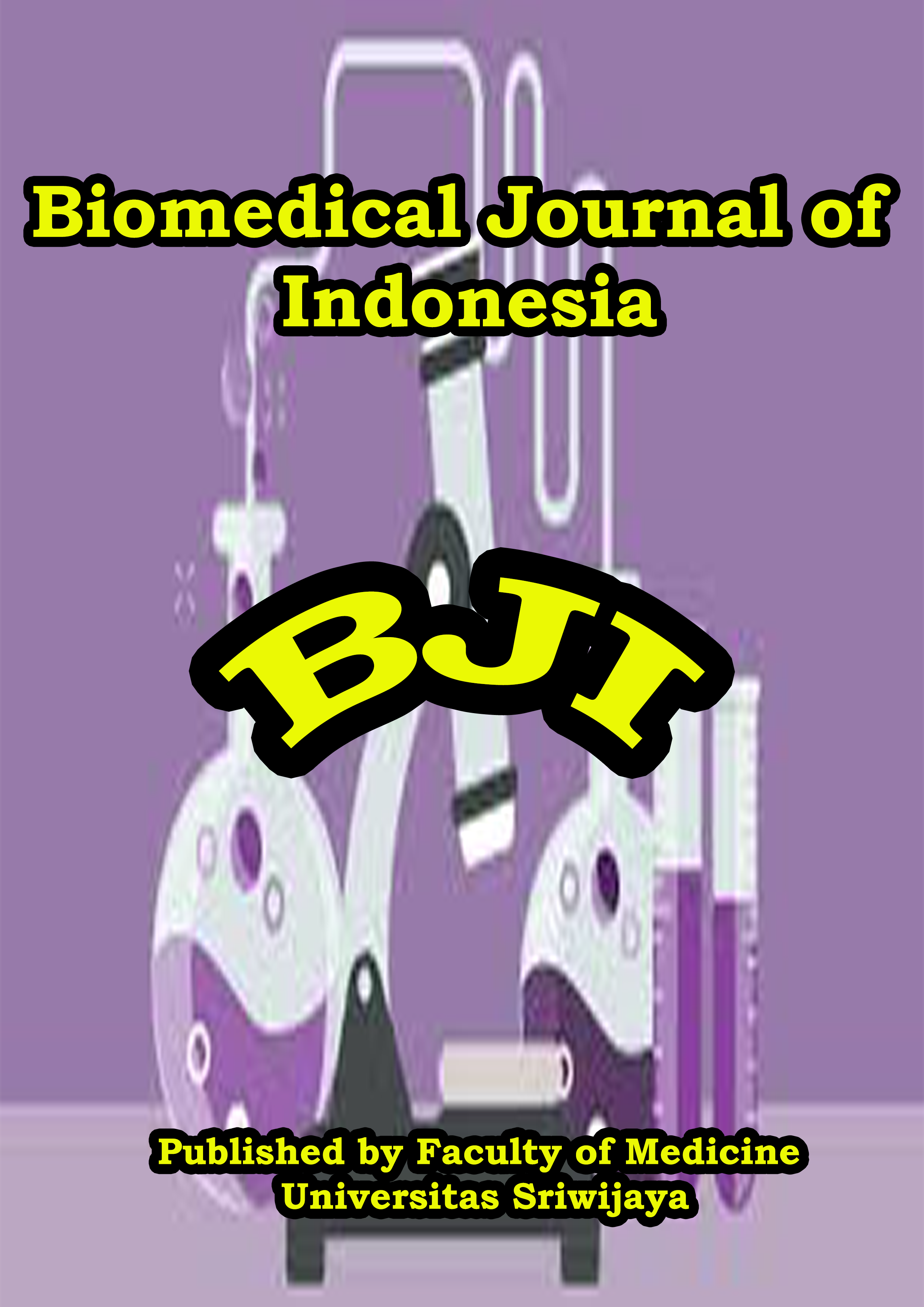Knowledge And Perceptions of Nutrition and Weight Among First-Year Medical Students at Sriwijaya University
Main Article Content
Introduction. Medical students of Sriwijaya University batch 2019 are new students who don’t have much knowledge about nutrition. In addition, new students also don’t know how to calculate Body Mass Index (BMI) through body height and weight. This study aimed to know the level of nutritional knowledge and the suitability of weight perception among the medical students of Sriwijaya University batch 2019. Methods. Descriptive research with a cross-sectional research design was conducted in Health Clinic UPT of Sriwijaya University and the Faculty of Medicine of Sriwijaya University in September 2019. The sample of this study was all medical students from Sriwijaya University batch 2019 who met the inclusion and exclusion criteria. The data was obtained through direct measurement and filling M-GNKQ questionnaire and weight perception questionnaire online. Results. In this study, 222 students met the inclusion and exclusion criteria, with 74 male students and 148 female students. As many as 70.7% of students have normal nutritional status. The average value of nutrition knowledge is 18.21 (45.5%) with the lowest value 0 and the highest value 32. Of all of the students, only 52.3% can perceive body weight correctly. The rest, as much as 33.3% is exaggerating perception and 14.4% is reducing perception. Conclusion. The knowledge of nutrition among the medical students of Sriwijaya University batch 2019 is still quite low and there are still many students who mistakenly perceive their weight.
2. Sirirassamee T, Phoolsawat S, Limkhunthammo S. Relationship between body weight perception and weight-related behaviours. J Int Med Res. 2018;46(9):3796–808.
3. Shin A, Nam CM. Weight perception and its association with socio-demographic and health-related factors among Korean adolescents. BMC Public Health. 2015;15(1):1–9. Available from:
4. Shagar P., Shakiba N, Rahmah M. Factors Associated With Misperception of Own Weight Status among 18-21 Year Old University Students. IOSR J Nurs Heal Sci. 2014;3(5):25–31.
5. Naeeni MM, Jafari S, Fouladgar M, Heidari K, Farajzadegan Z, Fakhri M, et al. Nutritional knowledge, practice, and dietary habits among school children and adolescents. Int J Prev Med. 2014;5(2):S171–8.
6. Worsley A, Wang WC, Byrne S, Yeatman H. Different patterns of Australian adults’ knowledge of foods and nutrients related to metabolic disease risk. J Nutr Sci. 2014;3:20–5.
7. Brumboiu MI, Cazacu I, Zunquin G, Manole F, Mogosan CI, Porrovecchio A, et al. Nutritional status and eating disorders among medical students from the Cluj-Napoca University centre. Med Pharm Reports. 2018;91(4):414–21.
8. Mehmood Y, Al-Swailmi FK, Al-Enazi SA. Frequency of obesity and comorbidities in medical students. Pakistan J Med Sci. 2016;32(6):1528–32.
9. Khan ZN, Assir MZ, Shafiq M, Chaudhary AEG, Jabeen A. High prevalence of preobesity and obesity among medical students of Lahore and its relation with dietary habits and physical activity. Indian J Endocrinol Metab. 2016;20(2):206–10.
10. Ren X, Chen Y, He L, Jin Y, Tian L, Lu M, et al. Prevalencia de bajo peso, el sobrepeso y la obesidad en estudiantes universitarios de la región de Anhui (China). Nutr Hosp. 2015;31(3):1089–93.
11. Assefa H, Belachew T, Negash L. Socio-demographic factors associated with underweight and stunting among adolescents in Ethiopia. Pan Afr Med J. 2015;20:252.
12. Maehara M, Rah JH, Roshita A, Suryantan J, Rachmadewi A, Izwardy D. Patterns and risk factors of double burden of malnutrition among adolescent girls and boys in Indonesia. PLoS One. 2019;14(8):15–8.
13. Jayawardena R, Byrne NM, Soares MJ, Katulanda P, Hills AP. Prevalence, trends and associated socio-economic factors of obesity in South Asia. Obes Facts. 2013;6(5):405–14.
14. Zhu C, Wang B, Gao Y, Ma X. Prevalence and relationship of malnutrition and distress in patients with Cancer using questionnaires. BMC Cancer. 2018;18(1):1–6.
15. Bukenya R, Ahmed A, Andrade JM, Grigsby-Toussaint DS, Muyonga J, Andrade JE. Validity and reliability of general nutrition knowledge questionnaire for adults in Uganda. Nutrients. 2017;9(2):1–11.
16. Kliemann N, Wardle J, Johnson F, Croker H. Reliability and validity of a revised version of the General Nutrition Knowledge Questionnaire. Eur J Clin Nutr. 2016;70(10):1174–80.
17. Hargrove EJ, Berryman DE, Yoder JM, Beverly EA. Assessment of nutrition knowledge and attitudes in preclinical osteopathic medical students. J Am Osteopath Assoc. 2017;117(10):622–33.
18. Valmórbida JL, Goulart MR, Busnello FM, Pellanda LC. Nutritional knowledge and body mass index: A cross-sectional study. Rev Assoc Med Bras. 2017;63(9):736–40.
19. Badrin S, Daud N, Ismail SB. Body weight perception and weight loss practices among private college students in Kelantan state, Malaysia. Korean J Fam Med. 2018;39(6):355–9.
20. Vijayalakshmi P, Thimmaiah R, Reddy SSN, Kathyayani B V., Gandhi S, BadaMath S. Gender differences in body mass index, body weight perception, weight satisfaction, disordered eating and Weight control strategies among Indian Medical and Nursing Undergraduates. Investig y Educ en Enferm. 2017;35(3):276–84.
21. Radwan H, Hasan HA, Ismat H, Hakim H, Khalid H, Al-Fityani L, et al. Body mass index perception, body image dissatisfaction and their relations with weight-related behaviors among university students. Int J Environ Res Public Health. 2019;16(9).
22. Riahi R, Motlagh ME, Heshmat R, Qorbani M, Daniali SS, Kelishadi R. Body Weight Misperception and Psychological Distress Among Children and Adolescents: The CASPIAN-V Study. Osong Public Health and Research Perspectives 2019;10(5):315–24.
23. Sonneville KR, Thurston IB, Miliren CE, Gooding HC, Richmond TK. Weight misperception among young adults with overweight/ obesity associated with disordered eating behaviors. Int J Eating Dis.. 2016; 49(10): 937-46.
24. Peltzer K, Pengpid S. Underestimation of weight and its associated factors in overweight and obese university students from 21 low, middle and emerging economy countries. Obes Res Clin Pract. 2015;9(3):234–42.

